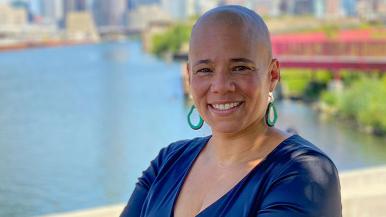Arika Clark was well aware of her risk for heart problems.
“I have a family history of heart disease,” Arika says. “My great uncle had it, and my mom was sitting on his lap as a child when he keeled over dead from it.”
But her risks took a back seat in her mind to her work as the founder and owner of Thrive Epic, a company that creates online courses for businesses. Her busy job is satisfying but stressful, and Arika began having worrying chest pain and tightness. Urged by friends and family, she went to her doctor, who referred her to the new RUSH Center for the Prevention of Cardiovascular Disease in July 2021. She was their first patient — and took their first appointment at 8 a.m.
The center at RUSH Oak Park Hospital is the brainchild of Daniel Luger, MD, a RUSH cardiologist, and Max Fitzgerald, MD, a specialist in physical rehabilitation. Its goal is to treat patients at risk for cardiovascular disease before they have serious heart problems with a full range of preventive care and behavior change methods.
“The clinic takes patients with diabetes, high blood pressure, high cholesterol,” Luger says. “We screen for sleep hygiene, musculoskeletal issues, depression and other mental health concerns. All of these are risk factors for heart problems down the line.”
'They really cared about me'
Arika’s first appointment was unlike any other doctor appointment she’d ever had.
“I felt like they really cared about me,” she says. “The first time I came in, they said ‘Arika, we want to know everything about you.’ I thought, who are these people? They sat and talked to me forever. They just wanted to know everything about me.”
Luger says that’s by design.
“The calling card is taking a patient-centered, holistic approach, which captures the patient experience and addresses their unique needs,” he says. “When we first meet with any patient, we have them take us through every minute of every single day, to help understand how they flow through their day. That way we can anchor behavioral changes in their normal day. We can conveniently time medications, plan when they have a little time to exercise, etc.”
During her appointments at the center, as well as within online messages and phone calls, Clark says she began to learn about her own body’s needs, and how to make smaller lifestyle changes that could have a big impact.
“I now understand heart health a little more,” she says. “I’m not a fried food eater, and that’s what I thought heart health was. But they found strategies to help me manage my stress, and work with me where I’m at. They sent me messages to check on my progress. They helped me make small changes, like eating a little less meat. Most doctors want you to do such radical changes, but they focus on obtainable small shifts that are more manageable to me but make a huge difference.”
The result? Clark still has her satisfying job, and her chest tightness and palpitations have disappeared.
Bringing change
“My heart is feeling really good,” she says. “I eat a little better, I understand now that there are foods that people say are healthy but not for people with a family history of heart disease. And I feel very taken care of and supported.”
Luger said that his work at the center has expanded his knowledge as well.
“This is very much a mutual exchange,” he said. “We also use the clinic appointments as a space to check in, to reflect, to talk about your ideas. I learn from all of my patients, and Arika is one of those patients that I learned a lot from.”
Because of the length and thoroughness of clinic visits, the center is currently limited to about 100 patients, and booked out four to five months in advance. Luger said he hopes to expand the center and eventually conduct more outreach to underserved populations to foster better health equity in heart health.
“No matter who the patient is, what it takes is engaging the patient, understanding their lifestyle, and bringing changes that they can integrate,” Luger says. “Then we see great outcomes. Because we’re getting at the root cause.”




